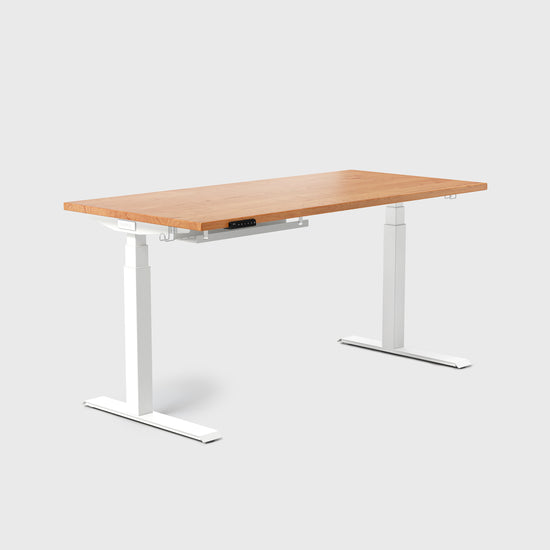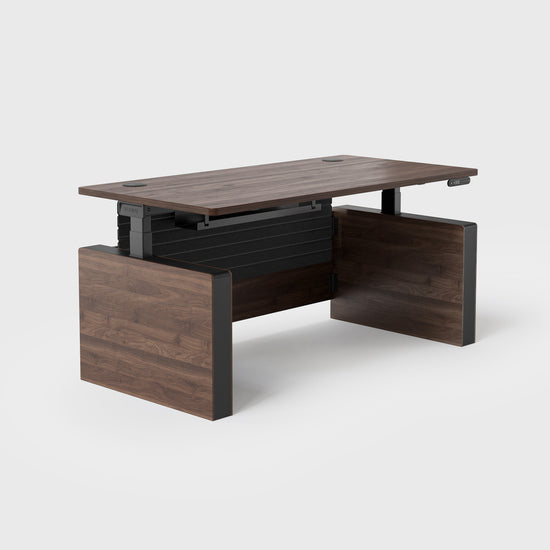Designing a home workspace isn’t just about functionality, it’s about crafting an environment that feels intentional, inspiring, and truly yours. Blank walls make a room feel unfinished—but too many people wait for the “perfect” idea and end up with nothing at all.
In today’s home office design ideas, wall art isn’t just decoration. It’s a vital element of your cohesive and modular workspace that enhances mood, focus, and style. Whether you’re working from a corner studio or a spacious home office, the right office decorations can help you craft your workspace into a place that feels inspiring and personal.
In this article, we'll dive into practical placement techniques, smart frame choices, creative home workspace design strategies, and the real benefits wall art brings to your work life, and help you create a cohesive and emotionally resonant space.
Why Wall Art Matters in a Cohesive Workspace
A workspace isn't just where you get things done—it's where you think, reflect, and often spend a third of your waking hours. Just as a well-made desk like the Vernal standing desk supports your physical posture, the right visual environment supports your mental posture. Turning blank walls into curated galleries does more than fill a space—it supports well‑being.
-
Personalization empowers: Research by psychologist Craig Knight at Exeter University found that employees allowed to personalize their workspace—including art and plants—become up to 32% more productive and report higher well‑being than those in uniform offices space.
-
Enriched visual environments boost performance: Compared to minimalist setups, art‑rich workspaces improve mood and cut burnout and stress.
-
Art nurtures mental clarity: Contemplating beautiful art enhances abstract thinking and psychological distance from daily pressures. It's a visual anchor to reduce cognitive fatigue.
So when you're looking at wall space, don't see decoration—see opportunity: a chance to shape your work zone into a space that inspires and supports your best self.
The Golden Rule of Placement: The 145 cm Principle
One consistent rule across home office design ideas: hang artwork so its center sits about 145 cm (57 in) from the floor.
Why 145 cm?
This height places art at average eye level—comfortable for both seated and standing views—and is standard in galleries and museums. UX and interior sources explain it as typically the most visually pleasing and accessible middle ground, especially in high ceilings or furniture-dense rooms.
When to adapt the rule
-
Above desks or sofas: Lower the piece slightly so it doesn’t hover too high. Aim for 10–20 cm (4–8 in) above furniture top for cozy alignment.
-
High ceilings: You might raise the center slightly to stay proportional with the wall height.
-
At staircases or corridors: Shift heights according to sightlines as people walk past—often slightly above eye level.
How to measure
-
Find the artwork’s center (frame height ÷ 2).
-
Add the distance from the frame top to its hanging wire.
-
Position your hook so the artwork’s center ends up at ~145 cm from the floor.
-
Always dry‑run with paper templates or tape before drilling.
Key placement tips
-
Center art horizontally relative to the desk, not the wall, to create balance.
-
If placing art above your monitor, ensure it starts at least 20 cm above the screen for visual breathing room.
-
For gallery-style layouts, treat the entire group as a single visual unit with a shared center point at eye level.

Choosing the Right Frames and Materials
Whether you’re hanging original art or a printed photograph, frame materials and design matter for both longevity and visual effect.
Frame color and mood
Light wood or white frames: let the art breathe and keep the eye focused on the image—not the frame.
Dark frames: great at anchoring black-and-white photography or artworks with deep tones; they create contrast and a refined focus.
Material quality = long-term enjoyment
Use acid-free mats and backing paper to prevent yellowing.
Invest in UV-protective or anti-reflective glass—these protect pigments and reduce glare, making the art easier to appreciate in bright workspaces. Avoid highly reflective glass in frames, especially near windows, to reduce glare during video calls or focus work.
Mix or match frames?
Mixing textures and finishes (wood, metal) can produce visual energy in gallery office wall décor ideas. Stick to one color family, but vary thickness or texture to add depth.
But for a more calming and refined workspace, a unified frame style often feels more cohesive and modular.
Styling Strategies: Picture Wall Layouts That Work
If you’re looking to transform a blank wall into art-forward focal point, here are tried-and-true options:
Symmetrical Grid
-
Ideal for repeating patterns or themed prints.
-
Creates a clean, orderly canvas—especially suitable above a desk, credenza or cabinet.
Salon / Gallery Wall
-
Layer frames of varying sizes using the center-line or top-line alignment.
-
Works well in larger spaces—makes for a rich, curated visual experience.


Wave or Organic Shape
-
Anchor a central piece and extend supporting pieces in a gentle curve or abstract formation.
-
Adds motion and softness—ideal for creative-minded individuals.

Guiding Line Alignment
-
Choose a theme and hang the pictures so that the viewer’s gaze is guided upward at an angle. Mix vertical and horizontal frames, and make sure all frames are spaced evenly—about 2 to 4 inches (5 to 10 cm) apart is ideal.
-
People who enjoy mixing styles but still want a sense of order.

Flowing Contours
-
By combining pictures and frames of different sizes, you can create a smooth, flowing outline on your gallery wall. If an image is too large or too small (but not too valuable!), you can crop the print or add a larger or smaller frame, then place the image in a frame different from what you originally planned.
-
Guide the flow of movement and the eye with continuous visual lines, adding a sense of fluidity and creativity to the workspace.

The Subtle Power of Art While You Work
Art in your workspace isn't decoration alone—it can actively support productivity and mental well-being.
Calm focus
Soft landscape: calm colors like greens, blues or muted abstract shapes promote restful mental states. According to Attention Restoration Theory, viewing natural images supports cognitive focus renewal.
Energizing inspiration
Bold, high-contrast or vibrant art pieces (like abstracts or colorful prints) can sharpen energy and boost mood during heavier tasks. Choosing such art intentionally allows you to modulate emotional tone in your workspace.
Visual “pause” and mental resets
Taking breaks by glancing at art can interrupt stress loops—helping you return with renewed clarity.
Zoning with art
Use art to demarcate zones—above your ergonomic, professional‑grade standing desk, a series of vertically aligned pieces can visually anchor your work area.
Use different-sized groupings on sidewalls to subtly separate storage, shelving, or reading corners.
Personal meaning
Framed personal photographs, handwritten notes, or travel mementos invite a sense of identity and belonging—key elements for emotional connection in your workspace.
Tips for a More Refined Workspace Look
If you’re outfitting a spacious, premium workspace and want to enjoy truly polished home office design ideas, here’s how to do it with intention and flair.
Feature with one standout piece
-
A single large artwork above your desk or behind your standing desk makes a bold focal point.
-
Choose carefully: let it reflect your energy and resonate with your work style.
Harmonize colors and materials
-
Use wall art colors that echo the tones of your standing desk surfaces or frame finishes.
-
This creates an integrated visual language—every element speaks to the same design system. Keep color palettes unified—carry tones from your art into your chair upholstery, lamp shades, or storage bins.
Integrate with workspace essentials
-
Pair wall art with VERNAL’s desk shelf, side cabinet to build zones that feel unified.
-
Add a sculptural object or two (like a ceramic or small lamp) to build layers around the wall art.
Build modular visual flow
-
With L‑shaped desk layouts or corner zones, treat each segment as its own mini gallery.
-
Thoughtful alignment ties multiple areas into one cohesive workspace design.
You don’t have to wait until the wall is perfect—or until you find the “ultimate” piece—to begin. Start with what you love and let it guide you. Tape up frames, take a step back, and adjust until it feels just right.
Wall art isn’t mere decoration—it’s a strategic part of home office design ideas and office decorations that help you focus, feel intention, and enjoy where you work every day.
At VERNAL, we believe in building a cohesive and modular workspace that inspires your flow. Your standing desk is just the beginning. Add thoughtfully hung wall art, fine materials, and curated accessories—and you’ll craft your workspace into something that doesn’t just look good, but also feels good to be in.
Ready to elevate your setup? Browse our ergonomic, professional‑grade standing desks and suite of workspace essentials—then let your wall become part of your workspace magic.
VERNAL Hard Wood Standing Desk


VERNAL Hard Wood Standing Desk
- Regular price
-
From
$899.99 - Regular price
-
$1,289.99 - Sale price
-
From
$899.99
VERNAL Executive Standing Desks


VERNAL Executive Standing Desks
- Regular price
-
From
$639.99 - Regular price
-
$899.99 - Sale price
-
From
$639.99



